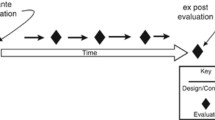Abstract
In the Human-Computer Interaction (HCI) community, software usability has primarily been concerned with the presentation of information, more precisely with the user interface. However, some usability problems can prove costly to fix if the changes require modifications that reach beyond the presentation layer, namely those that cannot be easily accommodated by the software architecture. Taking into account some usability requirements earlier in the software development cycle, specifically prior to the architectural design phase, can reduce the cost of these modifications. There is a scarcity of methods and guidelines with the scope to direct users in eliciting the usability requirements that can impact the software architecture.
This paper proposes a usability-driven adaptation of the quality attribute workshop (QAW) to assist software development organizations in discovering and documenting usability requirements. It shows how this method can be integrated into a software development process, by discussing how the existing software framework workflows can be adjusted to take this new activity into consideration. A preliminary exercise was conducted to help discern the utility and the limits of the proposed method. Participants with different levels of knowledge of usability and comprehension of the system being developed found the method constructive, as it guided them in identifying the architecturally relevant usability requirements. It also helped determine the usability aspects that would not necessarily have been defined if this technique had not been employed.




Similar content being viewed by others
References
Abran, A., Khelifi, A., Suryn, W., Seffah, A. 2003. Usability meanings and interpretations in ISO standards. Journal of Software Quality (11):325–338.
Artim, J.M. 1997. Integrating user interface design and object-oriented development through task analysis and use cases. In: ACM SIG CHI Bulletin, vol. 30, no. 4.
Barbacci, M., Ellison, R., Lattanze, A., Stafford, J.A., Weinstock, C.B., Wood, W.G. 2003. Quality Attribute Workshop (QAW), 3rd ed. CMU/SEI-2003-TR-016, Pittsburgh, PA: Software Engineering Institute, Carnegie Mellon University.
Bass, L., John, B.E., Kates, J. 2001. Achieving Usability through Software Architecture, CMU/SEI-TR-2001-005. Pittsburgh, PA: Software Engineering Institute, Carnegie Mellon University.
Bass, L., John, B.E. 2003. Linking usability to software architecture patterns through general scenarios. Journal of Systems and Software 66:187–197.
Beck, K. 2000. Extreme Programming Explained: Embrace Change. Addison-Wesley.
Bevan, N. 1995. Measuring Usability as Quality of Use. Journal of Software Quality (4):115–140.
Cockburn, A. 2001. Agile Software Development. Addison-Wesley.
Constantine, L., Biddle, R., Noble, J. 2003. Usage-centered design and software engineering: Models for integration. In: Proceedings of the International Conference on Software Engineering (ICSE), pp. 106–113.
Ferre, X., Juristo, N., Windl, H., Constantine, L. 2001. Usability basics for software developers. IEEE Software 18(1):22–29.
Ferre, X. 2003. Integration of usability techniques into the software development process. In: Proceedings of ICSE Workshop: Bridging the Gap Between Software Engineering and Human-Computer Interaction, Portland, USA, pp. 28–35.
Folmer, E., Van Gurp J., Bosch J. 2003. Investigating the relationship between software architecture and usability. Accepted for Software Process—Improvement and Practice: Special Issue on Bridging the Process and Practice Gaps between Software Engineering and Human-Computer Interaction.
Folmer, E., Bosch, J. 2003. Usability patterns in software architecture. In: Proceedings of the 10th International Conference on HCI, Crete, Greece, pp. 93–97.
Folmer, E., Bosch, J. 2004. Architecting for usability: A survey. Journal of Systems and Software, Elsevier, pp. 61–78.
Goldberg, A. 1984. Smalltalk-80: The Interactive Programming Environment. Addison-Wesley.
ISO/IEC 9241-11. 1998. Ergonomic requirements for office work with visual display terminals (VDTs) – Part 11: Guidance on usability, ISO/IEC 9241-11:1998.
ISO/IEC 13407. 1999. Human-centered design process for interactive system teams.
John, B.E., Bass, L., Adams, R.J. 2003. Communication across the HCI/SE divide: ISO 13407 and the Rational Unified Process. In: Proceedings of the 10th International Conference on HCI, Crete, Greece.
Juristo, N., Windl, H., Constantine, L. 2001. Special issue on usability engineering in software development. IEEE Software 18(1).
Krutchen, P. 2000. The Rational Unified Process: An introduction, 2ed. New Jersey, NY: Addison-Wesley.
Krutchen, P., Ahlqvist, S., Bylund, S. (eds). 2001. User interface design in the rational unified process. Object Modeling and User Interface Design. Boston: Addison-Wesley, pp. 131–196.
Landauer, T.K. 1995. The Trouble with Computers: Usefulness, Usability and Productivity. Cambridge, MA: MIT Press.
Nielsen, J. 1993. Usability Engineering. Boston, MA: Academic Press Inc.
Pfaff, G. 1985. User Interface Management Systems. Berlin: Springer.
Phanouriou, C. 2000. UIML: A Device-Independent User Interface Markup Language. Ph.D. Thesis, Virginia Polytechnic Institute and State University.
Rafla, T., Oketokoun, R., Wiklik, A., Desmarais, M., Robillard, P.N. 2004. Accommodating usability driven changes in existing software architecture. In: Proceedings of the IASTED 8th International Conference on Software Engineering and Applications. Cambridge, MA, pp. 150–154.
Rafla, T., Robillard, P.N., Desmarais, M. 2006. Investigating the impact of usability on software architecture through scenarios: A case study on Web systems. Journal of Systems and Software 79(3):415–426.
Robillard, P.N., Kruchten, P., D’astous, P. 2003. Software Engineering Process with UPEDU. Boston: Addison-Wesley.
Seffah, A., Hayne, C. 1999. Integrating Human Factors into Use Cases and Object-Oriented Methods, ECOOP’99, LNCS, No. 1241.Springer Publishing, pp. 2401–254.
Seffah, A., Desmarais, M., Metzker, A. 2005. Software and Usability Engineering: Prevalent Myths, Obstacles and Integration Avenues. In: Seffah, A., Gulliksen, J., Desmarais, M. (eds). Human-Centered Software Engineering: Integrating Usability in the Development Process. Springer Publishing, pp. 17–36.
Sousa, K., Furtado, E. 2003. RUPi—A unified process that integrates human-computer interaction and software engineering. In: Proceedings of the International Conference on Software Engineering (ICSE), pp. 41–48.
Acknowledgments
This work was supported in part by the Natural Sciences and Engineering Research Council of Canada (NSERC) under grants A0141 and 121923-03. The authors would like to express their sincerest gratitude to the participants for taking part in the experiment and also for providing the details of their work.
Author information
Authors and Affiliations
Rights and permissions
About this article
Cite this article
Rafla, T., Robillard, P.N. & Desmarais, M. A method to elicit architecturally sensitive usability requirements: its integration into a software development process. Software Qual J 15, 117–133 (2007). https://doi.org/10.1007/s11219-006-9009-9
Published:
Issue Date:
DOI: https://doi.org/10.1007/s11219-006-9009-9




